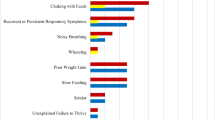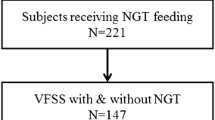Abstract
Aspiration is an often unrecognized comorbidity in children with Down syndrome with serious medical consequences. This retrospective chart review of swallow study reports characterizes oral and pharyngeal phase dysphagia and diet modifications on videofluoroscopic swallow studies (VFSS) in a large cohort of children with Down syndrome. A total of 158 pediatric patients (male = 95; female = 63; mean age 2.10 years, SD 3.17 years) received an initial VFSS at a pediatric teaching hospital as part of their medical care. A total of 56.3 % (n = 89) children had pharyngeal phase dysphagia with aspiration and deep laryngeal penetration occurring most frequently. Of the 61 patients who aspirated, 90.2 % (n = 55) did so silently with no cough or overt clinical symptoms. In 76.7 % of cases of pharyngeal phase dysphagia, a functional feeding plan, with use of thickened liquids or change in feeding system to control flow rate and/or bolus size, was able to be established, which allowed children to continue eating by mouth. Thickened liquids (76.7 %, n = 46) were the most effective adaptation, with change in feeding system alone effective in only 8.3 % (n = 5) cases. Oral phase dysphagia was reported in the majority of patients (63.8 %, n = 88/138); however, this was not predictive of pharyngeal phase dysphagia. Age, sex, and reason for referral, including prior clinical symptoms, did not have a statistically significant impact on the presence of dysphagia. This comprehensive review has application to clinical understanding and management of dysphagia in children with Down syndrome.
Similar content being viewed by others
References
Weir K, McMahon S, Barry L, Ware R, Masters IB, Chang EB. Oropharyngeal aspiration and pnuemonia in children. Pediatr Pulmonol. 2007;42(11):1024–31. doi:10.1002/ppul.20687.
Tutor JD, Gosa MM. Dysphagia and aspiration in children. Pediatr Pulmonol. 2012;47(4):321–37. doi:10.1002/ppul.21576.
Frazier JB, Friedman B. Swallow function in children with Down syndrome: a retrospective study. Dev Med Child Neurol. 1996;38(8):695–703. doi:10.1111/j.1469-8749.1996.tb12139.x.
O’Neill AC, Richter GT. Pharyngeal dysphagia in children with Down syndrome. Otolaryngol Head Neck Surg. 2013;149(1):146–50. doi:10.1177/0194599813483445.
McDowell KM, Craven DI. Pulmonary complication of Down syndrome during childhood. J Peds. 2010;158(2):319–25.
Ram G, Chinen J. Infections and immunodeficiency in Down syndrome. Clin Exp Immunol. 2011;164(1):9–16. doi:10.1111/j.1365-2249.2011.04335.x.
Yang Q, Rasmussen SA, Friedman JM. Mortality associated with Down’s syndrome in the USA from 1983 to 1997: a population-based study. Lancet. 2002;359(9311):1019–25.
Arvedson J, Rogers B, Buck G, Smart P, Msall M. Silent aspiration prominent in children with dysphagia. Int J Pediatr Otorhinolaryngol. 1994;28(2–3):173–81.
Brumbaugh DE, Accurso FJ. Persistent silent aspiration in a child with Trisomy 21. Curr Opin Pediatr. 2002;14(2):231–3.
Lefton-Greif MA, Carroll JL, Loughlin GM. Long-term follow-up of oropharyngeal dysphagia in children without apparent risk factors. Pediatr Pulmonol. 2006;41(11):1040–8. doi:10.1002/ppul.20488.
Newman LA, Kecklyey C, Petersen MC, Hamner A. Swallowing function and medical diagnoses in infants suspected of dysphagia. Pediatrics. 2001;108(6):e106. doi:10.1542/peds.108.6.e106.
Weir KA, McMahon S, Taylor S, Chang AB. Oropharyngeal aspiration and silent aspiration in children. Chest. 2011;140(3):589–97. doi:10.1378/chest.10-1618.
Leder SB, Suiter DM, Duffey D, Judson BL. Vocal fold immobility and aspiration status: a direct reduplication study. Dysphagia. 2012;27(2):265–70. doi:10.1007/s00455-011-9362-0.
Simon M, Collins M. The pediatric lung and aspiration. Perspect Swallowing Swallowing Disord (Dysphagia). 2013;22(4):142–54.
Friedman B, Frazier JB. Deep laryngeal penetration as a predictor of aspiration. Dysphagia. 2000;15(3):153–8.
Bull MJ. Health supervision for children with Down syndrome. Pediatrics. 2011;128:393. doi:10.1542/peds.2011-1605.
Hsieh FY, Block DA, Larsen MD. A simple method of sample size calculation for linear and logistic regression. Stat Med. 1998;17:1623–34.
Author information
Authors and Affiliations
Corresponding author
Ethics declarations
Conflict of interest
The authors declare that they have no conflict of interest.
Rights and permissions
About this article
Cite this article
Jackson, A., Maybee, J., Moran, M.K. et al. Clinical Characteristics of Dysphagia in Children with Down Syndrome. Dysphagia 31, 663–671 (2016). https://doi.org/10.1007/s00455-016-9725-7
Received:
Accepted:
Published:
Issue Date:
DOI: https://doi.org/10.1007/s00455-016-9725-7




